Abstract
For the handball player, a complex athletic training is directly involved in achieving the main objectives of the handball game to score as many goals as possible and to achieve interceptions of throws. In this regard, in our research, in order to support the medical handball players, we have introduced swimming sessions in the training programs. This study was to statistically highlight the optimization of motor fitness parameters such as height, power, maximum power, strength and speed, by practicing swimming as a complementary sport in the preparation of medical student members of the representative handball team. Methods: This research was conducted on twenty amateur athletes handball players, aged between 19 and 25 years, being divided into two equal groups, with ten students for each group. In carrying out this research, the subjects were tested using the Myotest PRO device using the Squat Jump sample applied to the two groups by initial testing, intermediate after the preparatory period and the final testing after the competition period. Results: following the processing of the results of the two groups, for the three tests, an average evolution of 16% of the parameters during the preparatory period is observed, and of about 5% in the pre-competitive and competitive periods, for the experiment group, while the values of the control group have generally recorded a stagnation of values or even a slight decrease in the pre-competitive and competitive stages..
Keywords: Fitness-motor, handball players, myotest, plyometrics, swimming
Introduction
Training in handball has a special role, especially physical training, which ultimately determines the sports performance in training and competitions. In fact, this is the pivot for all other components of the training, constituting the very starting point for the entire training process. It is known that the handball game requires an aerobic capacity at maximum values with direct implication on the handball game, especially on the endurance and frequent changes of pace, being a fast and demanding game, with continuous changes of regulation. The essential element, the throw, we can say that it is a fundamental skill in handball because it leads both to the proximity of the opposing goal and to the scoring of a goal (Galazoulas et al., 2020). Athletes are forced to face the ever-increased demands imposed by the evolution of sports technique and tactics in high performance handball (Buse, Georgescu, Paunescu et al., 2022), all this suggests the need to approach training guided by the specific needs of the team when dealing with young handball players (Ruscello et al., 2021). In a study conducted by Hermassi et al. (2019), it is emphasized the importance of maximizing the force for the lower limbs, when an increase in throwing speed and a high detachment from the ground is desired. A coherent integrated training with higher indices of physical development and a high level of knowledge of the game will lead to performance at the level of international requirements, which requires players rapid reactions to the opponents actions (Barbu & Stoica, 2020). According to the literature, strength and power training programs have been demonstrated to be effective in improving athletic capabilities in team-sport player (Bauer et al., 2019; Chaabene et al., 2018; Fathi et al., 2019; Manou et al., 2019). Swimming offers a wide range of exercises that can be performed from simple to complex or from easy to hard and can be adapted to any person, depending on the possibilities of the subject, for an appropriate request. Swimming regularly interspersed among other activities, provides several benefits such as: it works the whole body (through the styles of swimming, bras, crawl, back and butterfly), also addresses the internal organs (cardiovascular system, lungs and helps to lower blood pressure) (Marcin, 2017). A study conducted by Kaun and Garipova (2017), on 100 students of the State Academy of Physical Culture, Sport and Tourism in Kazan, claims that only 45 minutes of swimming in the pool contributes to improving the blood supply to the brain, balancing the processes of excitation and inhibition of the central nervous system, accelerating metabolic processes and relieves fatigue. For an efficient approach in the general physical training of the juniors in handball, having as a primary objective the education of the functional, general resistance by requesting the three basal, aerobic, lactacyd and alactacid energy systems, among other means of training, swimming is recommended as a complementary sport (Mihăilă, 2006). Following the literature review and a meta-analysis, Cormier et al. (2020) found that immersion in cold water is beneficial for a neuromuscular recovery and fatigue 24 hours after training in team sports. Thus, swimming sessions held 10 hours after the intense specific effort have positive effects on subsequent sports performance, operating, reporting an increase in performance compared to a natural, passive recovery (Lum et al., 2010). Consequently, it is the responsibility of the training process to solve a whole series of performing skills that involve differentiated training. Differentiated training aims at the relationship of collaboration and organization of forms of training (Buse et al., 2021; Buse, Georgescu, Pitigoi et al., 2022).
Problem Statement
Researchers suggested that to be played successfully, team handball players should possess a well-developed anaerobic and aerobic fitness (Gorostiaga et al., 2006). Fora motor performance in elite handball requires strength for both the muscles of the upper and lower limbs (Hermassi et al., 2019). Our approach was oriented in the direction of supporting medical students who due to the very busy curricular curriculum cannot participate throughout the year in specific trainings in handball. They must cope with short-term preparation with numerous intense efforts and qualifying matches at the regional university center. In this study we investigated the muscular parameters of the lower limbs such as: height, power, power max, force and velocity.
Research Questions
The current study focused on exploring and identifying how swimming is actuated as a complementary tool in the training of medical students handball players. The basic question of this study is whether swimming as a complementary sport can help in the preparation of medical students knowing that they have a limited time given to recreational or hobby activities. I hypothesized that medical handball players who participate in a period of intense training, and benefit from swimming sessions in a complementary way, can achieve outstanding sports performances.
Purpose of the Study
Statistically highlighting the optimization of some parameters of motor fitness such as height, power, power max, force end velocity, by practicing swimming as a complementary sport in the training of medical students members of the representative handball team.
Research Methods
Participants
The research was carried out on a number of 20students, members of the handball, male and female, from "Carol Davila" University of University of Bucharest, aged between 19-25 years, where goalkeepers are excluded. The players were divided into two groups of 10 (5 boys and 5 girls). Physiological characteristics of the subjects are presented in table 1. Before the study began, all the experimental procedures, benefits and risks of the study were explained to the participants, and they each provided written informed consent.
Materials
For this research, the subjects were tested and evaluated using the Myotest PRO device in the Squat Jump sample. This test has the advantage that it is not conditioned by the laboratory equipment that can be performed right in the training room. This device is set according to gender, height, weight and can store information about several subjects, having built-in analysis software that allows comparing current results with those previously recorded. For this study, the Squat Jump sample was used, the following parameters being tested: height, power, max power, final speed of force. This sample is generally addressed to the lower limbs measuring the contractile characteristics of the muscles. These values can provide relevant information for conducting training but also about detention that can positively or negatively influence the quality of sports efficiency.
Procedure
The research was carried out on two groups of 10 participants, tested simultaneously, in a similar order, at approximately the same time of day, with a difference of one two minutes. Throughout the entire research process, the compliance of ethical guidelines was ensured: athletes participated voluntarily, without any constraints; all were informed that, at any moment, they could decide to withdraw from the study; the participants remain anonymous, and data has been treated confidentially. An initial test was applied to both groups, after which a normal training program of 4 months followed with 2-3 workouts per week depending on the study program, in addition, throughout this period, the experiment group entered the swimming pool 1 to 2 times a week, on days without training. After this period, the intermediate testing was performed, followed by a pre-competitive and competitive period of 6 weeks, totaling 4 to 5 activities per week depending on the the competitive calendar; also, during this period, the experimental group entered the swimming pool at least 3 times a week but necessarily 20 minutes after intense efforts. At the end of this period, the final testing was carried out, 18-20 hours after the last training, to be sure that previously all players were engaged in the same type of activity. The objective of the test is to measure the contractile and intermuscular coordination properties of the muscles in the lower limbs. The test begins on the sound signal produced by the myotest machine by a jump followed by five jumps made as quickly as possible, in which contact with the ground it must be as short as possible and the height of the jump must be as high as possible. Each subject performed three attempts with the best result recorded.
Findings
Regarding the results obtained by student, according to the two groups, the statistics highlight some significant differences.
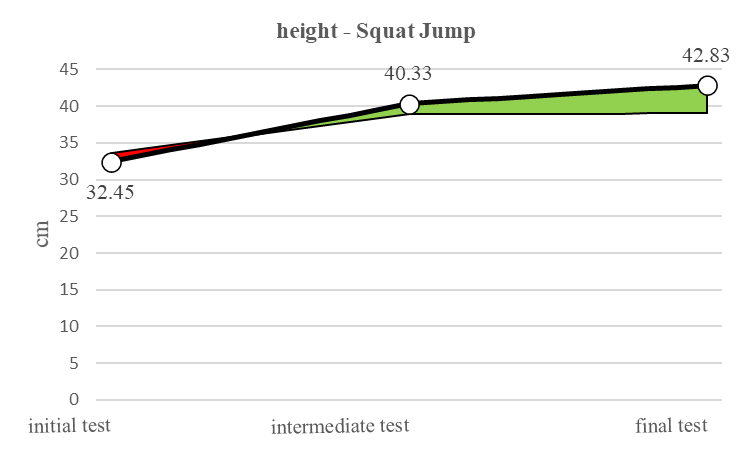
From Figure 1 the average values in the initial test are slightly higher for the control group by 1,2 cm. At the end of the preparatory period, the average value increased exponentially for the experiment group by 1.4 cm above the control group average. At the end of the competitive period these average values are clearly higher for the experiment group that benefited from swimming sessions, finally reaching 42.83 cm, compared to the control group which has a statistically insignificant average increase of only 0.1 cm from intermediate testing.
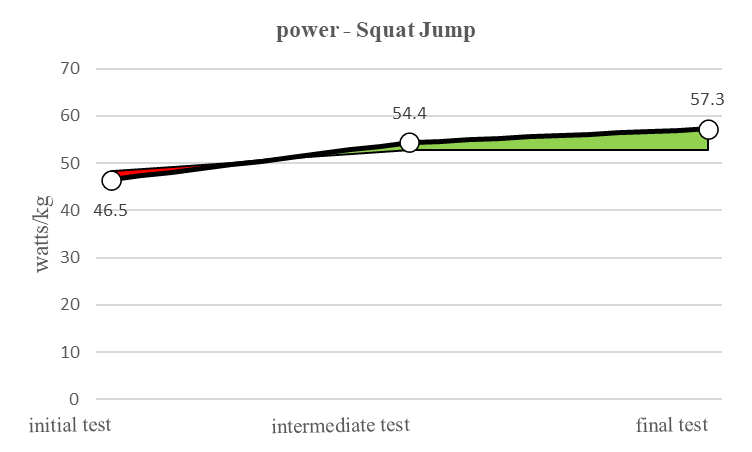
Figure 2 shows that the average values in the initial test are slightly higher for the control group by 1,9 watts/kg. At the end of the preparatory period, the average value increased exponentially for the experiment group to 1.66 watts/kg above the control group average. At the end of the competitive period these average values are significantly higher for the experiment group, eventually reaching 57.3 watts/kg, compared to the control group which has a statistically insignificant average increase of only 0.15 watts/kg from intermediate testing.
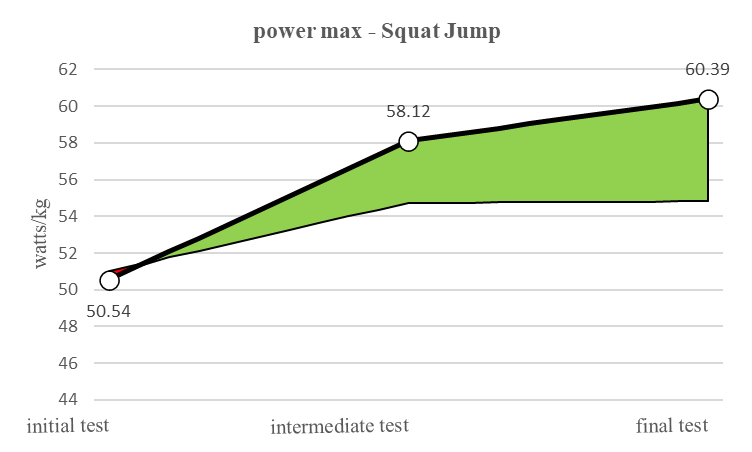
From the graph above (Figure 3) the average values in the initial test are slightly higher for the control group by 0,48 watts/kg. At the end of the preparatory period, the average value increased exponentially for the experiment group to 3.4 watts/kg above the control group average. At the end of the competitive period these average values are significantly higher for the experiment group, eventually reaching 60.39 watts/kg, compared to the control group that registers a decrease in the average value compared to intermediate testing.
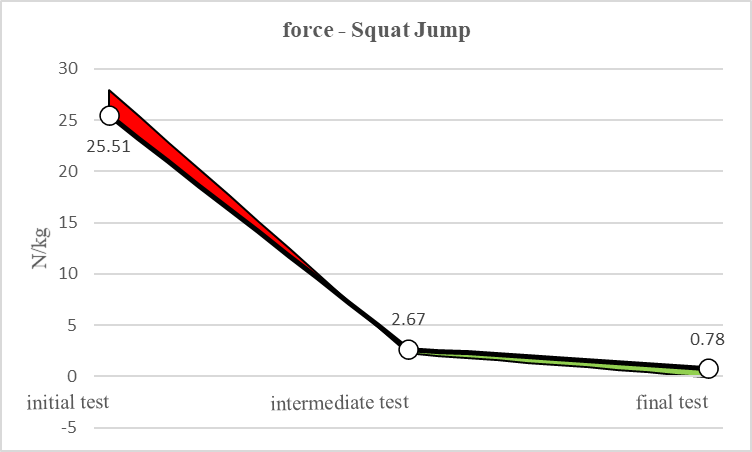
As shown in Figure 4 in initial testing, the control group has an average value higher than the experiment group by 1,6 N/kg. For both the experiment group and the control group, in the intermediate test, there is an evolution of the differences in the mean values, while at the end of the competitive period for the experiment group an exponential increase is observed while for the control group there is a negative difference from the intermediate test.
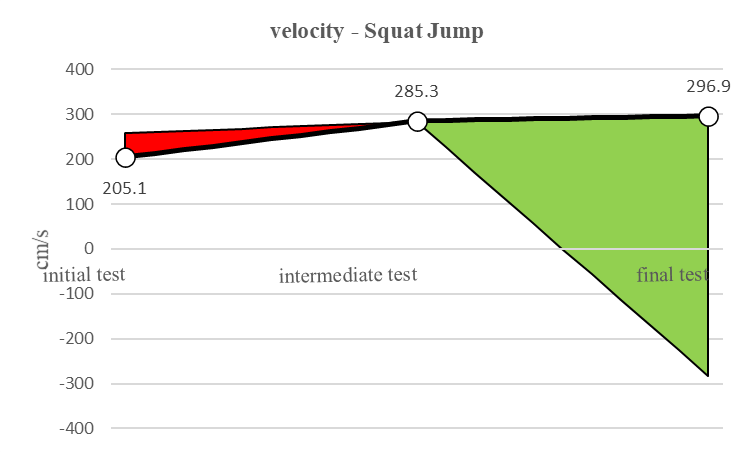
Figure 5 shows that in the initial test the control group has a significantly higher average value than the experiment group by 8,3 cm/s. For both the experiment group and the control group, in the intermediate testing, there is an evolution of the average values, while at the end of the competitive period for the experiment group, an exponential increase to 296,9 cm/s is continued, while for the control group a negative average value is recorded compared to the intermediate test.
Conclusions
This study explored the hypothesis according to which medical handball players who participate in a period of intense training, and benefit from swimming sessions in a complementary way, can achieve outstanding sports performances. Thus, swimming practiced in a complementary way in the training of medical students and carried out on a mandatory basis for 20 minutes after intense efforts, provides an increase in parameters in the preparatory period on average by about 16%, and in the pre-competitive and competitive period, by 5%. For the group of students who do not benefit from swimming sessions during intense efforts, some parameters have stagnated and others have seen slight decreases.
References
Barbu, D., & Stoica, D. (2020). Increasing the execution speed of offensive and defensive tactical actions in the football game at the time of transition. Journal of Sport and Kinetic Movement, 36(2), 5-13. http://www.jskm.ro/images/pdfs/36volii/increasing-the-execution-speed-of-offensive-and-defensive-tactical-actions-in-the-football-game-at-the-time-of-transition.pdf
Bauer, P., Uebellacker, F., Mitter, B., Aigner, A. J., Hasenoehrl, T., Ristl, R., Tschan, H., & Seitz, L. B. (2019). Combining higher-load and lower-load resistance training exercises: A systematic review and meta-analysis of findings from complex training studies. Journal of Science and Medicine in Sport, 22(7), 838-851. DOI:
Buse, P., Georgescu, L., Paunescu, C., Petrescu, S., Pricop, A., Petrescu, O., Mircica, M. L., & Pițigoi, G. (2022). Opinions on the importance of using swimming as a complementary sport in handball. Journal of Sport and Kinetic Movement, 39(1), 24-28. DOI:
Buse, P., Georgescu, L., Pitigoi, G., Paunescu, C., Petrescu, S., Pricop, A., & Petrescu, O. (2022). Findings regarding the introduction of post effort recovery on handball player. In Rusu, Oravitan, Cosma & Korkmaz (Ed.), New Trends of Fundamental Research in Sport Science From research to performance, Conference Proceedings Book, March 2022, Craiova, (pp. 330-333). Universitaria.
Buse, P., Pitigoi, G., Paunescu, C., Petrescu, S., Pricop, A., Petrescu, O., & Georgescu, L. (2021). The importance of using swimming as a complementary sport for handball players. In First International Conference For PhD Students And PhD Graduates In Sport Science, Craiova.
Chaabene, H., Prieske, O., Negra, Y., & Granacher, U. (2018). Change of Direction Speed: Toward a Strength Training Approach with Accentuated Eccentric Muscle Actions. Sports Medicine, 48(8), 1773-1779. DOI:
Cormier, P., Freitas, T. T., Rubio-Arias, J. Á., & Alcaraz, P. E. (2020). Complex and Contrast Training: Does Strength and Power Training Sequence Affect Performance-Based Adaptations in Team Sports? A Systematic Review and Meta-analysis. Journal of Strength and Conditioning Research, 34(5), 1461-1479. DOI:
Fathi, A., Hammami, R., Moran, J., Borji, R., Sahli, S., & Rebai, H. (2019). Effect of a 16 week combined strength and plyometric training program followed by a detraining period on athletic performance in pubertal volleyball players. Journal of Strength and Conditioning Research, 33(8), 2117–2127. https://pubmed.ncbi.nlm.nih.gov/29401199/
Galazoulas, C., Bassa, E., Gaitanou, A., Skoufas, D., & Karamousalidis, G. (2020). Upper-body vibration as part of warm-up: its effect on throwing velocity in elite adolescent handball players. Sport Sciences for Health, 16(2), 291-296. DOI:
Gorostiaga, E. M., Granados, C., Ibañez, J., González-Badillo, J. J., & Izquierdo, M. (2006). Effects of an entire season on physical fitness changes in elite male handball players. Medicine and Science in Sports and Exercise, 38(2), 357-366. https://pubmed.ncbi.nlm.nih.gov/16531907/
Hermassi, S., Chelly, M. S., Wagner, H., Fieseler, G., Schulze, S., Delank, K.-S., Shephard, R. J., & Schwesig, R. (2019). Relationships between maximal strength of lower limb, anthropometric characteristics and fundamental explosive performance in handball players. Sportverletzung · Sportschaden, 33(02), 96-103. DOI:
Kaun, V. A., & Garipova, A. N. (2017). Recreational swiming, article published at the International Conference "Problems and innovations of sports management, recreation and sports and health tourism". Russia, Kazan. https://www.sportacadem.ru/files/sbornik_smrisot_1-2_iyunya_20171.pdf#page=258
Lum, D., Landers, G., & Peeling, P. (2010). Effects of a Recovery Swim on Subsequent Running Performance. International Journal of Sports Medicine, 31(01), 26-30. DOI:
Manou, V., Aguilera, J. F. T., & Dalamitros, A. A. (2019). Aerobic power, anaerobic power, and vertical jumping ability over an entire competitive period in young elite male handball players. Human Movement, 20(4), 28-32. DOI:
Marcin, A. (2017). What Are the Top 12 Benefits of Swimming?. Retrieved on January 11, 2020, from https://www.healthline.com/health/benefits-of-swimming
Mihăilă, I. (2006). Handbal – optimizarea pregătirii fizice specifice la echipele de juniori [Handball - Optimization of specific physical training for junior teams]. Ed. University publishing house.
Ruscello, B., Castagna, C., Carbonaro, R., Gabrielli, P. R., & D’ottavio, S. (2021). Fitness profiles of elite male Italian teams handball players. The Journal of Sports Medicine and Physical Fitness, 61(5). DOI:
Copyright information

This work is licensed under a Creative Commons Attribution-NonCommercial-NoDerivatives 4.0 International License.
About this article
Publication Date
10 April 2023
Article Doi
eBook ISBN
978-1-80296-961-0
Publisher
European Publisher
Volume
5
Print ISBN (optional)
-
Edition Number
1st Edition
Pages
1-1463
Subjects
Education sciences, teacher education, curriculum development, educational policies and management
Cite this article as:
Bușe, P., Georgescu, L., Piţigoi, G., Petrescu, O., Petrescu, S., & Păunescu, C. (2023). Optimizing Motor Fitness, Through Swimming Sessions, For Medical Students Playing Handball. In E. Soare, & C. Langa (Eds.), Education Facing Contemporary World Issues - EDU WORLD 2022, vol 5. European Proceedings of Educational Sciences (pp. 882-889). European Publisher. https://doi.org/10.15405/epes.23045.88

